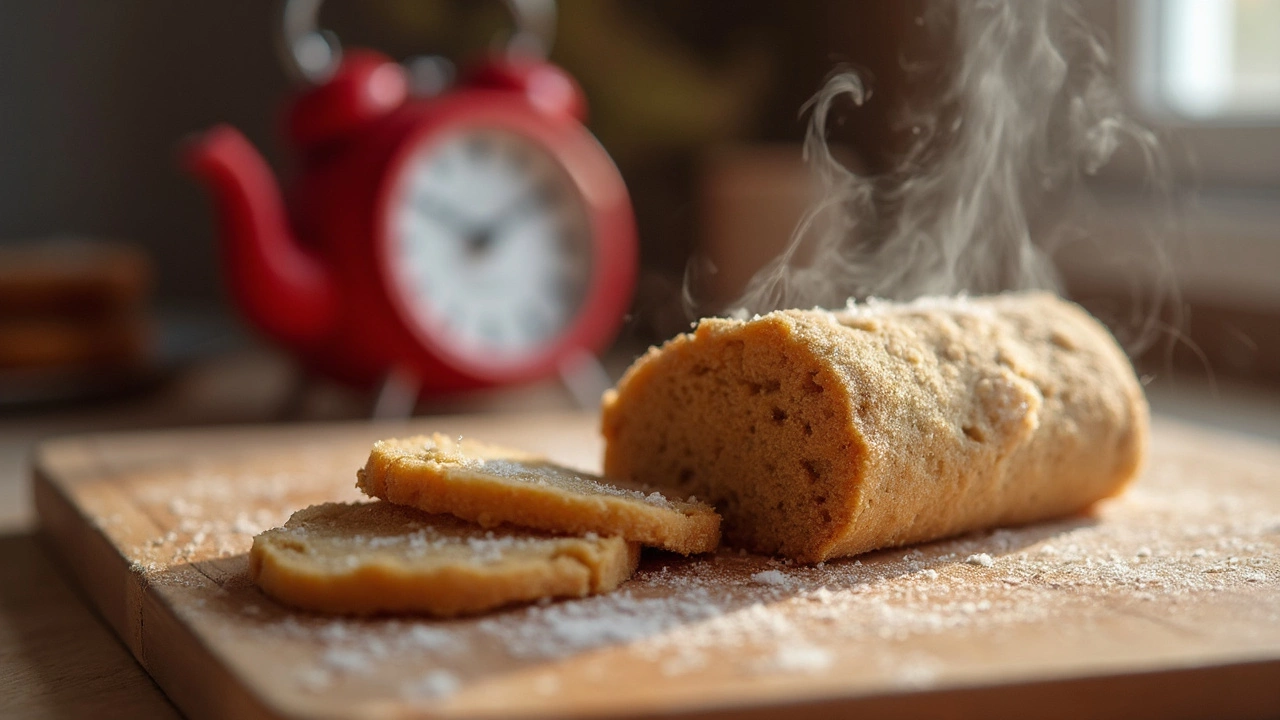
Cookie dough chilling time isn't just some fancy trick from baking shows—it's actually one of the biggest secrets behind chewy, thick cookies with crisp edges. Even just 30 minutes in the fridge can make dough less sticky, so it's way easier to roll and handle. But more importantly, chilling lets the flavors mix and helps the cookies bake up with the perfect texture.
If you've ever wondered why your store-bought dough needs chilling or why grandma always made her dough a night before, there's real science behind it. The cool-down period helps solidify the fats, so they don't melt as fast in the oven. Translation: less spreading, plumper cookies, and more control over the bake. It's not just about waiting—it's about getting the best version of your homemade cookies.
- Why Chilling Cookie Dough Matters
- How Long Should You Chill Different Dough Types?
- What Happens If You Skip Chilling?
- Tips for Faster and Better Chilling
- Troubleshooting: Problems with Chilled Dough
Why Chilling Cookie Dough Matters
Lots of people think homemade cookies are all about the recipe, but honestly, cookie dough chill time can change everything. When you pop your dough in the fridge, a few things happen that make a big difference:
- Flavor gets deeper: Letting the dough rest lets the flour soak up moisture, so the taste isn’t just surface-level. The sugars break down a bit and you end up with a richer, toastier flavor. One test by Cook’s Illustrated found that chilling dough overnight can boost the final cookie’s flavor big time, especially for chocolate chip and brown sugar-based cookies.
- Texture improves: Solid fats like butter firm up in the cold. When you bake chilled dough, the fats take longer to melt, so the cookies spread less on the pan. Translation: thick, chewy centers and crispy edges—just how most folks like them.
- Less stickiness, better shape: Warm dough is a mess to handle. Chilled dough firms up, making it easier to scoop, roll, and shape accurately, especially for cutout cookies and sugar cookies.
If you need proof, check this data comparing unchilled vs. chilled dough after baking for a standard chocolate chip recipe:
| Dough Condition | Cookie Width (inches) | Cookie Height (inches) | Flavor Rating (1-10) |
|---|---|---|---|
| Unchilled | 4.2 | 0.35 | 6 |
| Chilled (2 hours) | 3.4 | 0.58 | 8 |
| Chilled (overnight) | 3.1 | 0.65 | 9 |
Main takeaway? Chilling isn’t a pointless extra step. If you care about how your cookies taste and look, stick the dough in the fridge at least for a while before baking.
How Long Should You Chill Different Dough Types?
Chilling time really depends on the type of cookie dough you've whipped up. Not every dough is the same—some need just a quick rest, others benefit from a full-on overnight stay in the fridge.
For drop cookies, like chocolate chip or oatmeal, aim for at least 30 minutes, but an hour brings out richer flavor and chewier texture. Want those Insta-worthy thick cookies? Go for 2-24 hours. As a rule, the longer they chill (up to 48 hours), the deeper the caramel notes and nuttiness get. If you're short on time, half an hour is your bare minimum for a noticeable difference.
Cut-out cookies, like sugar cookies or gingerbread men, really do need to chill for at least 1-2 hours. The dough firms up and gets less sticky, making it easier to roll thin and keep those crisp shapes. If you try to roll them out right away, you'll end up with a mess or cookies that puff up instead of holding sharp lines.
Shortbread or slice-and-bake doughs should chill for at least an hour, but overnight works even better. It lets everything set, so when you slice, the dough holds its shape and doesn’t squish flat.
- Drop cookie dough: 1-2 hours for best results (minimum: 30 minutes)
- Cut-out cookie dough: 2 hours or overnight if you can
- Shortbread/slice-and-bake dough: 1-24 hours, with overnight as ideal
And if you end up leaving dough in the fridge a day or two—don't worry. Most cookie doughs are happy in there for up to 3 days, tightly wrapped. If it's been longer, just let it soften on the counter for about 10 minutes to make scooping or slicing easier before baking. A little planning pays off big time when you bite into that perfect homemade cookie.

What Happens If You Skip Chilling?
Skipping the fridge can totally change how your cookies turn out. If you bake cookie dough straight from the mixer without chilling, you'll notice a few things right away. The cookies will usually spread way more since the butter or other fats are still soft. That means you'll get thinner, flatter cookies instead of those bakery-style chewy chunks.
The taste takes a hit too. Chilling gives the flour time to soak up the wet ingredients, making the flavor deeper and more blended. With no chill time, cookies can taste a bit bland or just overly sweet instead of rich and caramelized. There's also texture—cookies right out of the oven might be greasy, with edges that get crisp before the centers are baked through. Basically, it's a fast track to cookies that look and taste homemade, but not always in a good way.
- If you really want thick, chewy cookies, cookie dough needs that fridge time.
- Melty butter means cookies bake faster on the outside and can stay raw in the middle.
- Chilling helps brown sugar and vanilla work their magic for deeper flavor.
Here's a quick peek at what changes if you skip chilling vs. chill for at least an hour:
| Cookie Dough State | Spread | Texture | Flavor |
|---|---|---|---|
| Unchilled | Very wide, thin | More likely to be greasy or crispy outside, doughy inside | Mild, less developed |
| Chilled (1+ hr) | Thicker, less spread | Chewy, crisp edges, tender middle | Richer, fuller flavor |
If you absolutely can't wait, you can pop your tray of shaped cookies into the freezer for 10-15 minutes—it's not the same as a full chill, but it does help a bit with spreading. Never hurts to have a backup plan.
Tips for Faster and Better Chilling
Waiting for cookie dough to chill can feel like forever, especially when you just want fresh cookies ASAP. Luckily, there are simple tricks that let you speed up the process without messing with the results. Whether you’re working with chocolate chip, sugar, or any classic homemade dough, a few tweaks can make the chill time more manageable and your cookies even better.
First up, don’t just leave a big hunk of dough in the bowl—spread it out. Flattening the dough into a disc about one-inch thick helps it cool more quickly and evenly. Wrap it snugly in plastic wrap or stick it in a zip-top bag before putting it in the fridge. If you’re making cut-out cookies, rolling the dough out first (between two sheets of parchment paper) saves time later and makes the chill way faster.
If you’re seriously short on time, the freezer is your friend. Pop the wrapped dough in the freezer for about 15 to 20 minutes instead of the usual hour in the fridge. Just don’t forget it in there—too long in the freezer can dry out your dough, so set a timer.
- Flatten dough for even and faster chill
- Wrap tightly to keep in moisture and prevent fridge smells
- For cut-out cookies, pre-roll dough before chilling
- Use the freezer for super quick results—but not more than 20 minutes for most doughs
One more solid tip: If you’re baking a big batch, portion the dough into balls before chilling. This helps them chill faster, and you can go right from fridge to oven. Plus, scooping cold dough can be extra tricky, especially if you’re using buttery recipes. Don’t forget—the chill step isn’t just about timing, but about giving your cookie dough the right texture and flavor for baking. Faster doesn't mean skipping, it just means chilling smarter.

Troubleshooting: Problems with Chilled Dough
Chilling cookie dough usually gives you better cookies, but sometimes throwing that dough in the fridge comes with its own set of headaches. Ever tried to scoop rock-hard dough or noticed your cookies don't spread right? Yep—those are classic issues worth fixing.
If your dough is too stiff to work with after it's been in the fridge, don't panic. Just let it sit at room temperature for 10-15 minutes. Target that sweet spot: still cool, but soft enough to scoop. Avoid microwaving dough; it heats unevenly and can mess with your cookie texture.
On the flip side, dough left in the fridge for more than 72 hours can start to dry out, especially if it wasn’t wrapped tightly. This leads to crumbly cookies that just don’t hold together. Wrapping dough in plastic wrap and popping it into an airtight bag or container stops this from happening.
- Cookie dough that turns out too dry after chilling may need a splash of milk or water—just a teaspoon, mixed in gently.
- If your cookies barely spread, let the dough warm up a bit longer before baking.
- Opposite problem? If you skipped the chill or your cookies are spreading out like pancakes, your dough probably got too warm. Toss it back in the fridge for 20 minutes and try again.
Sometimes, you’ll notice an odd color or dry spots. This happens if dough sits too long or wasn’t wrapped well. While still safe, the taste will likely suffer, so always check before using forgotten dough.
| Problem | Common Cause | Quick Fix |
|---|---|---|
| Rock-hard dough | Dough too cold after chilling | Let stand at room temperature 10-15 min |
| Dough too crumbly | Over-chilled or not airtight | Add 1 tsp milk or water, mix gently |
| Cookies don't spread | Dough too cold at baking | Allow dough to warm a few minutes |
| Cookies spread too much | Dough too warm | Chill again for 15-20 min |
| Weird flavor/dryness | Dough chilled too long or exposed to air | Check freshness or add a splash of milk |
Baking is full of little problems, but with a few simple tweaks, you’ll get that classic homemade result every time. The more you play around with chill time and dough handling, the easier it gets to spot what works with your favorite recipe.